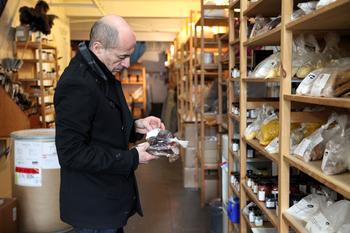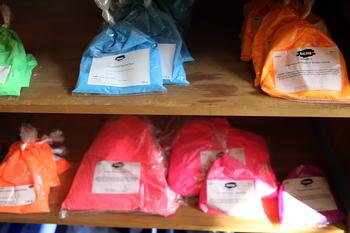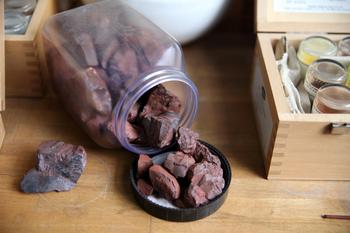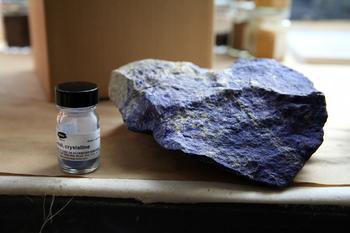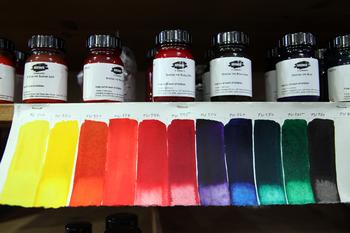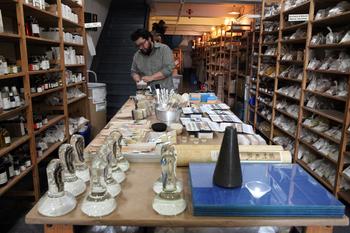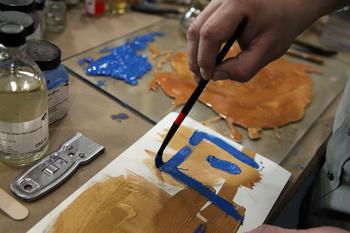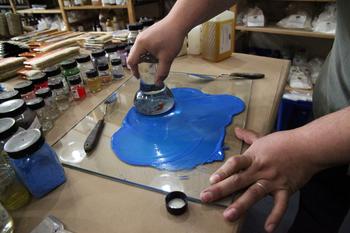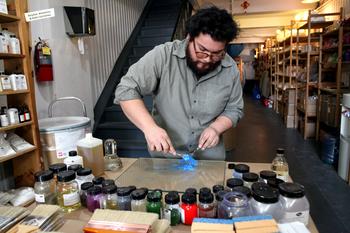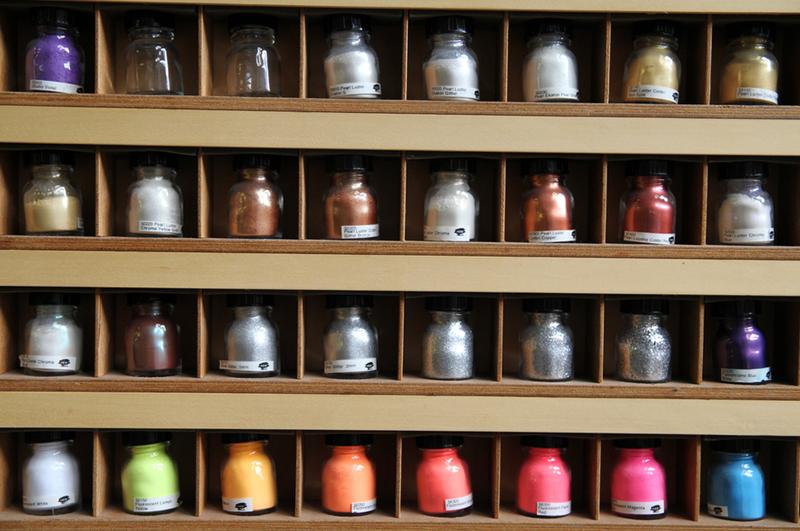
New York is a city of specialists from foodies to academics, laborers to shopkeepers. Every Wednesday, Niche Market will take a peek inside a different specialty store and showcase the city's purists who have made an art out of selling one commodity. Slideshow below.
Kremer Pigmente
247 West 29th Street
New York, NY 10001
When an art conservator needs to touch up a 17th century Italian Madonna's cloak, they don’t just pick up a tube of generic blue paint at the local art store. For those seeking to recreate an Old Master's palette, there’s a treasure trove of color on the west side of Manhattan. Step into Kremer Pigmente, specialist in historical pigments, and it’s possible to pick up an identical Fra Angelico Blue for that holy icon, sourced from the mineral Lapis Lazuli, just as it was in Michelangelo’s time.
Artists were some of the earliest alchemists, transforming natural minerals into colors for their transcendent works of beauty. Cavemen pulverized ochre into dark red power, added water or egg yolk and painted on the walls. In classical times, Romans extracted brownish sepia tones from the dried ink sacs of Adriatic cuttlefish. In South America, what we now know (and eat) as "red number 4" is derived from thousands of cochineal bugs.
Kremer replicates these processes in its water mill in Germany and sells the pigments, in powder form, to artists, luthiers and art restorers all over the world. The company's founder, Dr. George Kremer, figured out a way to meld his love of painting with his chemistry degree. Kremer started in 1977 with just five pigments. Now it manufactures over 1,000 pigments, using both historic recipes and new ones developed with organic chemistry in the lab. The store in Manhattan, where one can peruse colors ranging from Lead Tin Yellow to Green Quartz and Malachite, is Kremer’s only retail store in the United States.

Dr. Kremer travels the world searching for unique pigments, picking up snails for Tyrian purple, Italian earth for red, Lapis Lazuli rocks in Afghanistan for blue. The price of a pigment depends on its rarity and the difficulty of extraction. Lapis Lazuli is the most expensive — just five small grams cost $360. It’s generally museum conservators who buy in that price range, because religious icons were often purposely painted with expensive, exotic pigments. The pigments made from common earths are cheaper, 100 grams of Russian Green Earth is $27, and Venetian Red Earth is $8. Kremer also sells binders need to turn pigment into paint, different oil and acrylics, as well as turpentine, algae glue and chemicals used for making special mediums.
Contemporary artists like Celeste Phau patronize Kremer as well. She recently came in with a shopping list of linseed oil, cellulose, damar varnish and an acrylic medium to make a special glazing medium for oil painting. "I would say it's like painting with glass, it's really nice when you've got it all mixed up together, makes all the colors really pristine and kind of crystal-like," she said.
General manager Roger Carmona, who is an expert on the “personality” of each pigment, teaches free classes at the store on how to mix pigments into different mediums. "The benefit of making your own paint from a raw material is to have complete control over the paint, to be able to manipulate it in any way you want or any way that your imagination can serve, so you can sprinkle pigment on top, you can throw it, you can have an extremely rich color, and you learn a lot about painting this way," he said.
Demonstrating his technique, Carmona sprinkled a few tablespoons of Cobalt Cerulean Blue pigment onto a piece of glass, and then poured cold-press German linseed oil over it. Taking two palette knives, Carmona rapidly mixed the oil and powder together until it formed into a viscous, smooth mixture. To ensure that every particle of pigment made contact with the oil, he rolled glass muller in circles over what a layman would simply call "paint."
It’s artist Robert Padilla’s favorite store in the city. "I really love to do my own mixture, it's more unique," he said, while at Kremer choosing dark reddish pigments to stain wood for a project.
Some customers request all natural, historical pigments, but not Amalia Shaltiel. She got herself a "treat" of "Hostaperm Pink E," a synthetic florescent pink color. Having used Kremer products for years, she was delighted to chance upon the store and buy a pigment on her way to look at galleries in Chelsea. "It will go into a lot of different paintings and have a memory of the store," she said.
 (Photo: Roger Carmona mixing cobalt cerulean blue pigment with linseed oil./Sarah Kate Kramer for WNYC)
(Photo: Roger Carmona mixing cobalt cerulean blue pigment with linseed oil./Sarah Kate Kramer for WNYC)
Interview with Roger Carmona, general manager of Kremer Pigmente
What kind of materials are these pigments extracted from?
Mostly minerals, but actually raw earth that you see in Italy or rocks, so they're pulverized and they're cleaned, they're removed from any impurities such as pyrite and so they can derive from that, the synthetic organic pigments derive from both natural sources but mostly from organic chemistry. So they're lab created pigments that were historically found by accident by scientists or manufactured for painting purposes.
What's a binder?
If you were just to put water and pigment together and you don't add a binder, once the water evaporates you'll have pigment again, so you need something like a glue, if you will, or a binder that dictates what kind of paint it is. So in the case of oil paint, linseed oil or any kind of drying oil is the binder, in the case of acrylic paint, an acrylic emulsion or acrylic dispersion is the binder. Water colors are gum arabic and glycerin, so the binder is what makes the paint the kind of paint that is.
What do you mean by difference in pigment "personality?"
There are some pigments that are harder, some pigments are softer, some are very opaque, some are transparent, so in the layering process of these historical paintings, the technique that was use was very much taking in consideration this layering process and how light works. Pigment really is affiliated with light directly because they way we receive color is how light is bouncing back at you, so these different personalities the pigments have allow a certain kind of light to pass through them.

